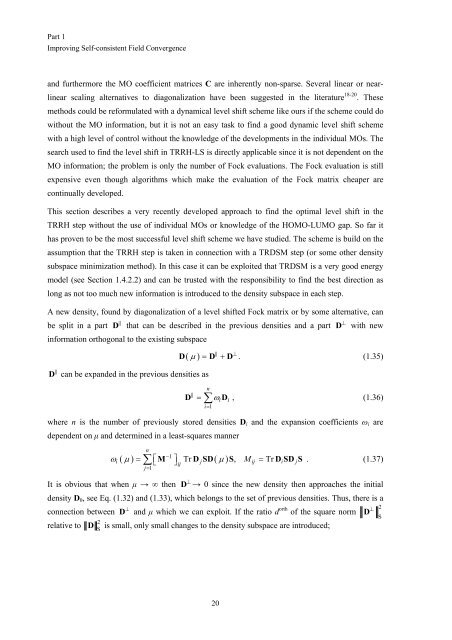Get my PhD Thesis
Get my PhD Thesis
Get my PhD Thesis
Create successful ePaper yourself
Turn your PDF publications into a flip-book with our unique Google optimized e-Paper software.
Part 1<br />
Improving Self-consistent Field Convergence<br />
and furthermore the MO coefficient matrices C are inherently non-sparse. Several linear or nearlinear<br />
scaling alternatives to diagonalization have been suggested in the literature 18-20 . These<br />
methods could be reformulated with a dynamical level shift scheme like ours if the scheme could do<br />
without the MO information, but it is not an easy task to find a good dynamic level shift scheme<br />
with a high level of control without the knowledge of the developments in the individual MOs. The<br />
search used to find the level shift in TRRH-LS is directly applicable since it is not dependent on the<br />
MO information; the problem is only the number of Fock evaluations. The Fock evaluation is still<br />
expensive even though algorithms which make the evaluation of the Fock matrix cheaper are<br />
continually developed.<br />
This section describes a very recently developed approach to find the optimal level shift in the<br />
TRRH step without the use of individual MOs or knowledge of the HOMO-LUMO gap. So far it<br />
has proven to be the most successful level shift scheme we have studied. The scheme is build on the<br />
assumption that the TRRH step is taken in connection with a TRDSM step (or some other density<br />
subspace minimization method). In this case it can be exploited that TRDSM is a very good energy<br />
model (see Section 1.4.2.2) and can be trusted with the responsibility to find the best direction as<br />
long as not too much new information is introduced to the density subspace in each step.<br />
A new density, found by diagonalization of a level shifted Fock matrix or by some alternative, can<br />
be split in a part D ⊥<br />
that can be described in the previous densities and a part D with new<br />
information orthogonal to the existing subspace<br />
D can be expanded in the previous densities as<br />
⊥<br />
D( µ ) = D + D . (1.35)<br />
n<br />
<br />
D = ∑ωiDi<br />
, (1.36)<br />
i=<br />
1<br />
where n is the number of previously stored densities D i and the expansion coefficients ω i are<br />
dependent on µ and determined in a least-squares manner<br />
n<br />
−1<br />
ω i ( µ ) = ∑ ⎡⎣M ⎤⎦<br />
Tr D jSD( µ ) S, Mij = Tr DiSD jS . (1.37)<br />
j=<br />
1<br />
ij<br />
⊥<br />
It is obvious that when µ → ∞ then D → 0 since the new density then approaches the initial<br />
density D 0 , see Eq. (1.32) and (1.33), which belongs to the set of previous densities. Thus, there is a<br />
⊥<br />
connection between D and µ which we can exploit. If the ratio d orth ⊥ 2<br />
of the square norm D<br />
S<br />
2<br />
relative to D<br />
S<br />
is small, only small changes to the density subspace are introduced;<br />
20

















